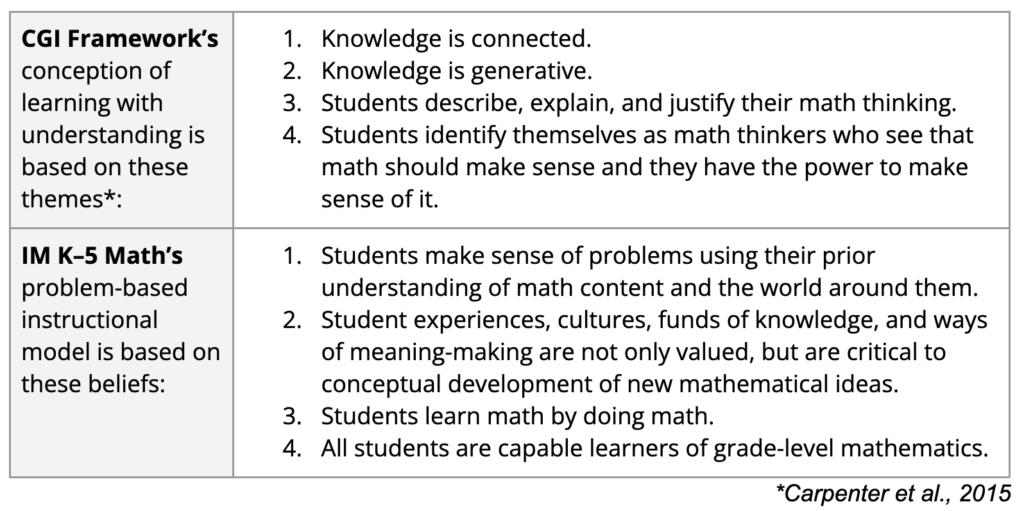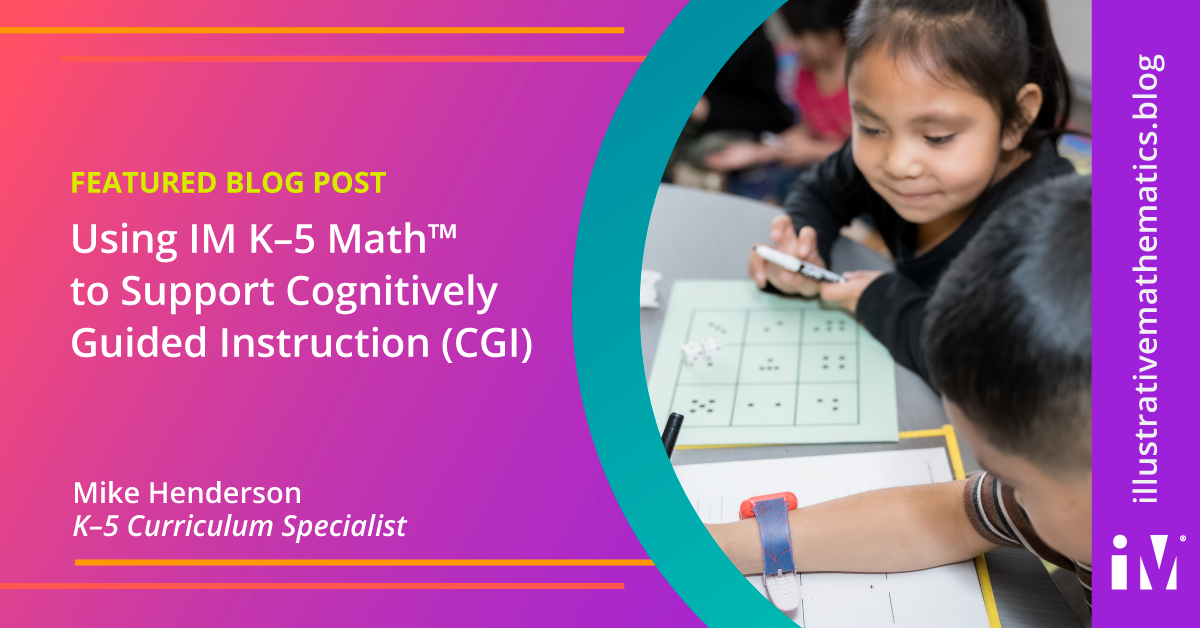By Mike Henderson
“The activities require skills that students are not taught prior to doing the activity. They’re expected to just jump right in. Why isn’t there more modeling or re-teaching of basic skills so students can be successful with the lesson?”
As teachers make the shift to IM K–5 Math’s problem-based instructional model, they often share similar concerns. This is especially true if the teachers have previously used materials or frameworks that emphasize direct modeling or an “I Do, We Do, You Do” structure. The question typically comes from a place of genuine interest in the success of all students in mathematics. No one wants a “sink-or-swim” learning environment, especially when students (and their teachers) may already have some hesitancy and fear when it comes to learning mathematics.
IM K–5 Math lessons intentionally encourage students to jump in to solving problems and exploring new math concepts without direct instruction on concepts, skills, or vocabulary that may traditionally be explicitly taught. This isn’t to say that students are expected to just figure it out on their own. Rather, the curriculum is intended to be a road map of coherent tasks that support teachers in learning about students’ mathematical thinking, connecting their mathematical ideas, and focusing on the important math topics for each grade.
This shift to a problem-based lesson structure may require teachers to play a different role than they are used to having in their classrooms, or experienced themselves as math students. They will be listening, facilitating, questioning, and synthesizing. Teachers must increase their abilities to listen for, make sense of, and use student thinking within and across lessons. They must also raise their awareness of who is sharing math ideas and how they are being positioned in terms of status inside and outside of the classroom.
“When students participate in these ways, we can better understand their mathematical thinking, and we often are surprised by what we learn. Even though students do not think about mathematics in the same way we might, they have knowledge on which to build.”
(Carpenter et al., 2015)
Professional development around cognitively guided instruction (CGI) supports teachers with making the shift in instructional practices to center student thinking. Grounded in research about how students learn and think about mathematics, CGI encourages teachers to use student thinking to drive instructional decisions, and use curriculum as a resource for a coherent set of standards-aligned problems.
While many teachers will agree that IM K–5 Math™ aligns with the CGI framework, some teachers trained in the principles of CGI find conflict between the push towards implementing a curriculum “with integrity” and using student thinking to drive instruction. However, implementing it with integrity includes the idea that it should be adjusted based on student thinking. In fact, there are a number of ways in which the CGI framework and the design principles behind IM K–5 Math are aligned.

Let’s take a closer look at some of the ways the IM K–5 Math curriculum can help teachers make the shift to a problem-based approach and listen and learn from student thinking.
A coherent scope and sequence of units, lessons, and activities that connect student learning within and across grade levels.
Students develop a deep understanding of mathematical concepts when units, activities, and representations are sequenced in a meaningful way. Teachers can trust that each course is fully aligned to the rigor and coherence of the standards, and follows a progression that supports fluency development.
Instructional routines that elicit and amplify student thinking are embedded in each lesson.
Through warm-up activities, Mathematical Language Routines, and routines like Card Sorts, students have repeated and structured opportunities to attend to, compare, and build on one another’s ideas. Each of these routines begin with listening to students and their ideas without direct input from the teacher. The structure of the task and the suggested questions in the teacher’s guide are designed to focus students and teachers on making connections to students’ current mathematical thinking.
Story problems and situations that are culturally and mathematically relevant to students, and offer multiple entry points and solution pathways.
Culturally relevant contexts allow students opportunities to develop positive self-identities as doers of mathematics. Many lessons also include sample launch questions that teachers may use to help students connect and share what they already know about a context or math topic before they begin to solve problems on their own. These questions are not just for student engagement, but should be used to learn more about students and position all students as knowledgeable and capable mathematicians.
Problem types such as Add To, Take From, and Compare, while varying the component of the relationship that is “unknown,” are systematically addressed in the early grades.
Students analyze, compare, and solve different addition and subtraction problem types in kindergarten through grade 2. They are used to elicit strategies, representations, and relationships between operations.
A limited set of representations are introduced in a coherent manner within and across grade levels to help students make sense of mathematical concepts and procedures or to help them solve problems.
Some CGI teachers may find that asking students to explicitly use a method or representation contradicts the approach of having students use whichever method or representation makes sense to them to solve problems. In IM K–5 Math, these approaches are not mutually exclusive. We introduce these representations by first allowing students to analyze them in service of understanding a concept, before being asked to try them out for themselves in service of solving a problem. Once the representation has been added to a student’s repertoire, they are invited to choose representations strategically to solve problems.
Teacher guidance for anticipating, understanding, advancing, and responding to student thinking is included at the unit, section, and lesson, and activity levels of each course.
- Lesson and activity narratives help teachers understand the goals of the lesson and provide anticipated student methods and representations.
- Activity launches invite students to share their current thinking and make connections to prior and cultural knowledge.
- Sample student responses often show flexibility in how students may approach problems.
- “Monitor for” prompts help teachers plan for the activity or lesson synthesis by guiding them on what to look for in student work during the lesson.
- Advancing Student Thinking questions help teachers support students to share their developing thinking and advance towards the goals of the lesson.
- Lesson and activity syntheses provide space for teachers to uncover student learning, and students to share their learning.
- Response to Student Thinking suggestions support teachers with making instructional adjustments based on student understanding from one lesson to the next.
- Teacher Reflection Questions support teachers to analyze and plan instructional decisions as they reflect on their students’ participation, mathematical identities, and mathematical thinking.
Making the shift to a problem-based approach that centers student thinking is challenging but very rewarding work as a math teacher. Like our math students, teachers come from diverse life and work experiences. The educative features in IM K–5 Math are meant to complement and not replace the teacher as the decision-maker in planning and instruction. For teachers new to this approach, the coherent, standards-aligned materials provide helpful structure that allow them to focus on student thinking and learning. For teachers more experienced in this approach, the materials provide a resource for a coherent set of tasks, options for eliciting students’ mathematical thinking, and support with flexibly building on what students already know to teach new mathematical concepts.
Cited Works: Carpenter, T.P., Fennema, E., Franke, M.L., Levi, L., & Empson, S.B. (2015). Children’s mathematics: Cognitively guided instruction. Heinemann.
Next Steps
Visit IM’s website to learn more about the instructional and educative features of IM K–5 Math highlighted in this post that support centering student thinking.
